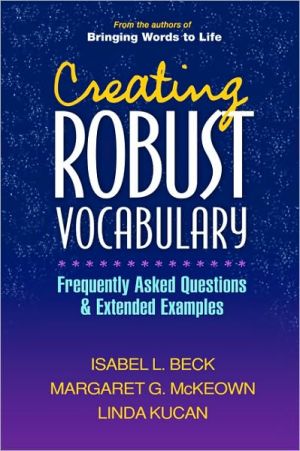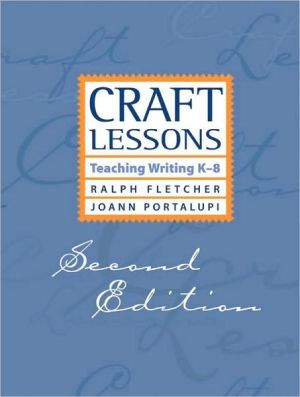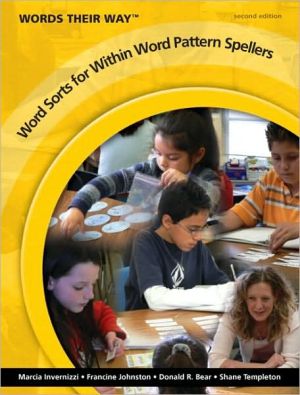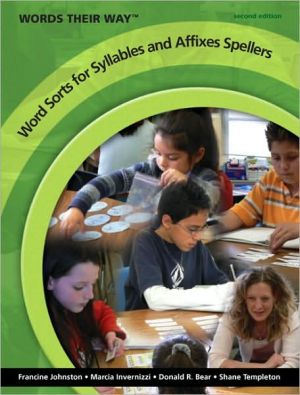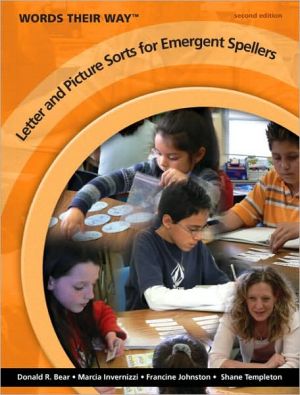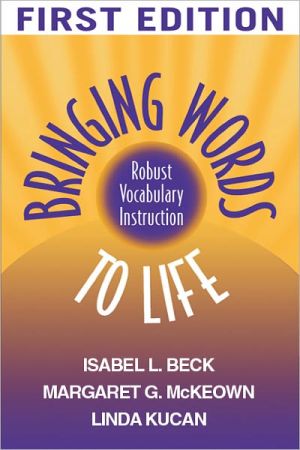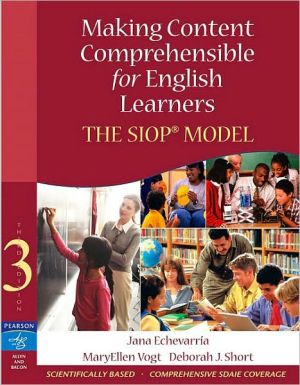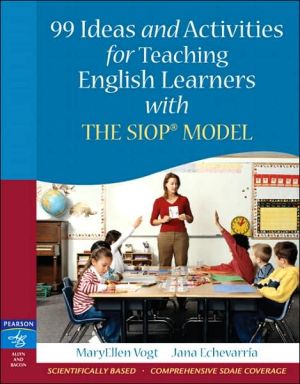Creating Robust Vocabulary: Frequently Asked Questions and Extended Examples
Bringing Words to Life has enlivened the classrooms of hundreds of thousands of teachers. Responding to readers' success stories, practical questions, and requests for extended examples, this ideal volume picks up where Bringing Words to Life left off. The authors present additional tools, tips, and detailed explanations of such questions as which words to teach, when and how to teach them, and how to adapt instruction for English language learners. They provide specific instructional...
Search in google:
Bringing Words to Life has enlivened the classrooms of hundreds of thousands of teachers. Responding to readers' success stories, practical questions, and requests for extended examples, this ideal volume picks up where Bringing Words to Life left off. The authors present additional tools, tips, and detailed explanations of such questions as which words to teach, when and how to teach them, and how to adapt instruction for English language learners. They provide specific instructional sequences, including assessments, for grades K-2, 3-5, 6-8, and 9-12, as well as interactive lesson planning resources. Invaluable appendices feature a quick-reference menu of instructional activities and a comprehensive list of children's books and stories with suggested Tier Two words for study. Children's Literature This follow-up from the authors of Bringing Words to Life builds on the belief that vocabulary must be both taught and used, preferably in writing, if it is to have any lasting effect on learners. Traditionally, vocabulary words have been assigned to a three-tier order with younger students beginning at tier one. The authors base their teaching philosophy on including and actually focusing on tier two words at younger levels. The remainder of the book focuses on the strategies for teaching tier two words, including which words to focus on, when and how to teach them and how to work with English language learners. Also provides tips for professional development. The authors cite research that connects early vocabulary acquisition to later reading comprehension as the basis for their belief in teaching younger students more challenging vocabulary. Included are a menu of activities in seven categories and a list of well-know books and stories that corresponding to tier two words. The book should be in the personal library of every elementary teacher. Reviewer: Meredith Kiger, Ph.D.
Ch. 1 Vocabulary and its effects 1Ch. 2 Which words? 7Ch. 3 The basics: when and how to teach 17Ch. 4 Some nitty-gritties of indstruction 39Ch. 5 What about English language learners? 59Ch. 6 Extended examples 65Ch. 7 Professional development 97App. A Menu of instructional activities 153App. B Some well-known books and stories and corresponding tier two word candidatesReferences 177Index 83
\ Children's Literature - Meredith Kiger\ This follow-up from the authors of Bringing Words to Life builds on the belief that vocabulary must be both taught and used, preferably in writing, if it is to have any lasting effect on learners. Traditionally, vocabulary words have been assigned to a three-tier order with younger students beginning at tier one. The authors base their teaching philosophy on including and actually focusing on tier two words at younger levels. The remainder of the book focuses on the strategies for teaching tier two words, including which words to focus on, when and how to teach them and how to work with English language learners. Also provides tips for professional development. The authors cite research that connects early vocabulary acquisition to later reading comprehension as the basis for their belief in teaching younger students more challenging vocabulary. Included are a menu of activities in seven categories and a list of well-know books and stories that corresponding to tier two words. The book should be in the personal library of every elementary teacher. Reviewer: Meredith Kiger, Ph.D.\ \ \ \ \ From the Publisher"If you don't already belong to a teachers-as-readers group, this book is reason to start one. The authors expand on the fundamentals that made their Bringing Words to Life such a treasure. They provide practical and specific ideas that will increase your knowledge of the 'what,' 'when,' and 'how' of vocabulary instruction, supported throughout by explanations that will stretch your thinking about the 'why.' Motivated by concerns raised by real teachers, this book contains everything you wanted to know about robust vocabulary instruction."--Mary E. Curtis, PhD, Director, Center for Special Education, Lesley University\ "Get out your highlighter when you read Creating Robust Vocabulary! The authors discuss why a robust vocabulary is essential to comprehension and how to enrich vocabulary instruction. This is one professional book you will really enjoy using--I couldn't put it down. Reading this book felt like having a marvelous conversation with the authors; they answered all my vocabulary-related questions, plus ones I didn't know I had. This invaluable, teacher-friendly resource inspired me to start implementing the robust vocabulary strategies with my first graders today, and they loved it!"--Ann Uzendoski, MS, first-grade teacher, Highwood Hills Elementary School, St. Paul, Minnesota\ "This highly anticipated book is the perfect follow-up to Bringing Words to Life, the seminal text on robust vocabulary instruction. The authors accomplish with aplomb what few are able to do; they take rigorously researched, evidence-based strategies for supporting vocabulary development and present them in a way that is accessible to teachers and engaging to students."--Michael D. Coyne, PhD, Department of Educational Psychology, Neag School of Education, University of Connecticut\ "I love this book! Beck, McKeown, and Kucan provide in-depth discussion of vocabulary and its effects on reading comprehension and writing; tier placement of words; and instructional sequence and activities. The Q&A format is reader friendly, and I find the extended examples of full lesson cycles especially useful for planning vocabulary instruction in my classroom. This book is a 'must read' for preservice and inservice teachers of every grade level, literacy coaches, educational researchers, and anyone who has ever had questions about vocabulary instruction. I will definitely be recommending this book to my colleagues."--Clover Noack, MEd, Reading Specialist/Curriculum Coordinator, Ft. Zumwalt School District, O’Fallon, Missouri\ "In this engaging volume, Beck, McKeown, and Kucan help readers to better understand their three-tiered approach to categorizing words, describe the ins and outs of selecting Tier Two words for instruction, and explain in detail how to teach word meanings before, during, and after reading. Examples drawn from the primary grades through high school illustrate the authors' approach to teaching Tier Two words for deep understanding. The examples and detailed descriptions give readers the knowledge needed to generate their own word selections and instructional approaches to fit a variety of texts and a variety of students."--Susan Watts Taffe, PhD, Division of Teacher Education, University of Cincinnati\ \ \ \ Journal of Adolescent and Adult Literacy"Creating Robust Vocabulary was developed as a companion volume to Bringing Words to Life....This new publication contains extensive instruction modeling that teachers will find immediately enticing....The two volumes together provide invaluable classroom resources for teachers....Beck, McKeown, and Kucan's indispensible scholarship, first in Bringing Words to Life and now with Creating Robust Vocabulary, provides teachers with a coherent and compelling framework for changing the landscape of vocabulary instruction in their classrooms."--Journal of Adolescent and Adult Literacy\ \
